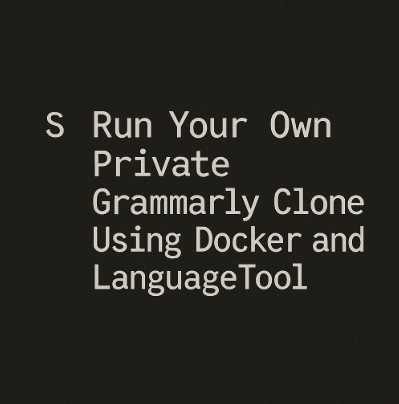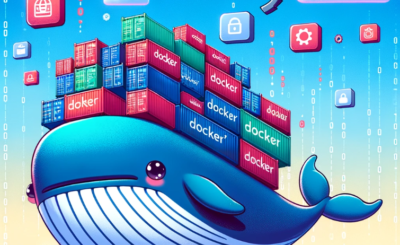In today’s digital landscape, effective communication is paramount. Whether you’re crafting marketing copy, writing technical documentation, or composing emails, impeccable grammar and spelling are crucial. While services like Grammarly offer excellent grammar checking capabilities, concerns about data privacy and security are increasingly prevalent. This article explores how to build your own private Grammarly clone using Docker and LanguageTool, offering a robust, secure, and customizable solution for your grammar and style checking needs. This comprehensive guide is aimed at intermediate to advanced Linux users, DevOps engineers, cloud engineers, and other tech professionals who want to take control of their data and build a powerful, private grammar checking system.
Table of Contents
Why Build Your Own Private Grammarly Clone?
Deploying your own private Grammarly clone using Docker and LanguageTool offers several key advantages:
- Data Privacy: Your documents remain on your servers, eliminating concerns about sharing sensitive information with third-party services.
- Security: You have complete control over the security infrastructure, allowing you to implement robust security measures tailored to your specific needs.
- Customization: You can customize the grammar rules and style guides to perfectly match your requirements, unlike the one-size-fits-all approach of commercial services.
- Cost-Effectiveness: While initial setup requires effort, long-term costs can be lower than subscription-based services, especially for organizations with high usage.
- Scalability: Docker’s containerization allows for easy scaling to accommodate increasing demands.
Choosing the Right Tools: Docker and LanguageTool
This project leverages two powerful technologies:
Docker: Containerization for Ease of Deployment
Docker simplifies the deployment and management of applications by packaging them into isolated containers. This ensures consistency across different environments and simplifies the process of setting up and maintaining your private Grammarly clone. Docker handles dependencies and configurations, making deployment on various systems (Linux, Windows, macOS) seamless.
LanguageTool: The Open-Source Grammar Checker
LanguageTool is a powerful, open-source grammar and style checker available under the GPLv3 license. It boasts extensive language support and offers a comprehensive rule set. Its API allows easy integration into your custom application, making it an ideal backend for your private Grammarly clone.
Setting Up Your Private Grammarly Clone: A Step-by-Step Guide
This section details the process of setting up your private Grammarly clone. We’ll assume a basic understanding of Linux command-line interface and Docker.
1. Setting up Docker
Ensure Docker is installed and running on your system. Installation instructions vary depending on your operating system. Refer to the official Docker documentation for details: https://docs.docker.com/
2. Creating a Dockerfile
Create a file named `Dockerfile` with the following content (you might need to adjust based on your LanguageTool version and desired web server):
FROM python:3.9-slim-buster
WORKDIR /app
COPY requirements.txt requirements.txt
RUN pip install -r requirements.txt
COPY . .
CMD ["gunicorn", "--bind", "0.0.0.0:8000", "your_app:app"]
You’ll also need a `requirements.txt` file listing your Python dependencies, including LanguageTool’s API client. Example:
languagetool-python
gunicorn
flask # or your preferred web framework
3. Building the Docker Image
Navigate to the directory containing your `Dockerfile` and `requirements.txt` and execute the following command:
docker build -t my-grammarly-clone .
4. Running the Docker Container
After building the image, run the container using the following command (adjust port mapping if needed):
docker run -p 8000:8000 -d my-grammarly-clone
5. Developing the Application
You’ll need to create a backend application (using Flask, Django, or a similar framework) that interacts with the LanguageTool API. This application will receive text from a user interface (which can be a simple web page or a more sophisticated application), send it to the LanguageTool API for analysis, and return the results to the user. This involves handling API requests, parsing LanguageTool’s JSON responses, and presenting the corrections in a user-friendly format.
Advanced Configurations and Enhancements
Beyond the basic setup, several advanced configurations can enhance your private Grammarly clone:
Integrating with a Database
Store user data, documents, and analysis results in a database (e.g., PostgreSQL, MySQL) for persistence and improved scalability. Use Docker Compose to orchestrate the database container alongside your application container.
Implementing a User Interface
Develop a user-friendly interface to interact with the backend. This could be a simple web application or a more complex desktop application.
Customizing LanguageTool Rules
LanguageTool allows customization of its rule set. This enables adapting the grammar and style checks to your specific requirements, such as incorporating company-specific style guides.
Load Balancing and Clustering
For high-traffic environments, consider load balancing and clustering your Docker containers to distribute the load and improve performance. This could involve using Docker Swarm or Kubernetes.
Use Cases and Examples
Basic Use Case: A writer uses the private Grammarly clone to check a blog post for grammar and spelling errors before publication. The application highlights errors, suggests corrections, and provides explanations.
Advanced Use Case: A company integrates the private Grammarly clone into its content management system (CMS) to ensure all published content meets a high standard of grammar and style. The integration automates the grammar checking process, improving efficiency and ensuring consistency across all published materials.
Frequently Asked Questions (FAQ)
Q1: What are the hardware requirements for running this?
The hardware requirements depend on the expected load. For low to moderate usage, a reasonably modern machine should suffice. For high loads, a more powerful server with sufficient RAM and CPU cores is recommended. Consider using cloud computing resources for scalability.
Q2: How secure is this compared to using a commercial service?
This solution offers enhanced security because your data remains within your controlled environment. You’re responsible for the security of your server, but this allows for implementing highly customized security measures.
Q3: What languages does LanguageTool support?
LanguageTool supports a wide range of languages. Check their official website for the latest list: https://languagetool.org/
Q4: Can I extend LanguageTool’s functionality?
Yes, LanguageTool’s rules can be customized and extended. You can create your own rules or use pre-built rules from the community.
Q5: What if LanguageTool’s API changes?
You’ll need to update your application accordingly. Regularly check the LanguageTool API documentation for changes and adapt your code to maintain compatibility.

Conclusion
Running your own private Grammarly clone using Docker and LanguageTool empowers you to take control of your data and customize your grammar and style checking process. This comprehensive guide provides a foundation for creating a secure and efficient solution. Remember to choose appropriate hardware resources, implement robust security practices, and monitor performance to ensure the system runs smoothly. By leveraging the power of Docker and LanguageTool, you can build a private grammar-checking solution tailored to your specific needs and maintain complete control over your sensitive data. Remember to continuously monitor LanguageTool’s API updates and adjust your code accordingly to ensure optimal performance and compatibility.Thank you for reading the DevopsRoles page!

